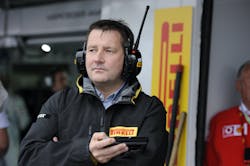After two wet weekends in Britain and Germany, Pirelli is expecting a dry and warm weekend at the Hungaroring: the first circuit to be opened behind the former Iron Curtain in 1986. The tight and twisty track is a permanent facility but has some of the characteristics of a street circuit, with a low average speed and very little grip, which gradually evolves as the weekend goes on and more rubber is laid down.
Pirelli is bringing the P Zero White medium tyre and P Zero Yellow soft tyre to Hungary: the same nomination as the German Grand Prix. This combination is designed to provide the best compromise between the grip that is needed to effectively negotiate the twisty Hungaroring and the durability required to combat the high ambient temperatures close to 30 degrees centigrade that usually characterize the Hungarian Grand Prix.
Traction and braking are the two key areas that challenge the tyres in Hungary, often causing high tyre temperatures that can increase degradation if the drivers do not look after their rubber. With the high number of tight corners and significant steering inputs, the external edges of the tyres are particularly prone to temperature spikes and wear, emphasizing the need for a smooth driving style.
Unlike Silverstone and Hockenheim, Pirelli will not bring any experimental tyres to free practice at the Hungaroring, meaning that each driver will have the usual allocation of six medium tyres and five soft tyres for the race weekend.
Paul Hembery: “Hungary will provide a very stark contrast to the circuits that we have just come from, being the slowest permanent track on the calendar. This does not make it any less demanding on the tyres though: in fact a twisty and slippery circuit will often put more heat through the tyre than a fast and flowing layout as the tyre is moving around more – particularly when the ambient temperatures are high. Having said that, in Hungary last year we saw some wet weather, so it’s important not to make any assumptions. Consequently, we are still lacking some information about the performance of our slick tyres under race conditions at the Hungaroring. Balancing the demands of speed and durability will be key to getting the most out of the tyres in Hungary, in order to keep degradation under control. Overtaking is traditionally difficult, so the drivers have an opportunity to use strategy in order to gain track position. Because of this, the work done in free practice will be vital when it comes to preparing the race strategy: an opportunity that has been denied to the teams recently because of bad weather in the build-up to the last two grands prix.”
Nico Hulkenberg (Force India): “I have some very good memories of racing at the Hungaroring, especially in 2010 when I finished sixth, which at that time was the best result of my career. Also, in 2009 I raced there in GP2 and won the race. So I’m looking forward going back there, also because I enjoy visiting the city of Budapest. Although it’s quite a slow circuit, it’s very difficult to get a good lap time because it’s a track where each corner flows into the next, so it’s quite challenging and you need to find the rhythm. In terms of tyres it asks a lot because you are nearly always in a corner and there are no long straights where the tyres get a chance to cool down. I think we should be able to fight for points this weekend because we have looked quite strong on circuits with not so many fast corners, such as Monaco and Valencia, so hopefully the circuit characteristics will suit our car.”
Pirelli’s test driver, Jaime Alguersuari: “Hungary is a bit like a go-kart track: it’s very good fun but a really tough race for the tyres and also the driver: your heart rate is at the highest that it is all year because of the high temperatures and not much cooling. In terms of set-up we run the highest downforce of the season, so we really maximise the aerodynamic potential of the car and this has an effect on the tyres too, with the front-left working particularly hard. With all the low to medium speed corners, combined traction and braking stability is very important: there is only one high-speed corner and that is really the only overtaking opportunity as well. Last year was a very complicated race where we started on the intermediate tyre and then moved onto the slick, but I think it should be quite different this year. The cars that should do well in Hungary this weekend are the ones that generate most downforce, because that is the most important factor there.”
Technical tyre notes:
• The start-finish straight of just over 700 metres is the only real straight on the entire circuit, with the tyres constantly loaded in a sequence of 14 corners for the rest of the 4.381-kilometre lap. The cars are at full throttle for just 10 seconds or so during the lap.
• The cars ride the kerbing in the chicane between turns six and seven as part of the racing line. The resulting impact generates a force on the tyre equivalent to 800 kilogrammes.
• The cars run high downforce in Hungary to maximize grip and a soft suspension set-up to improve traction, just like Monaco. The cars also need accurate turn-in for all the rapid changes of direction, so they tend to run with a stiff front end to guarantee precise roadholding. However it’s important for the car set-up not to accentuate tyre wear, which is a vital factor in Hungary.



